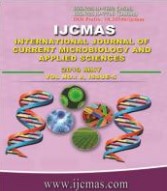


 National Academy of Agricultural Sciences (NAAS)
National Academy of Agricultural Sciences (NAAS)

|
PRINT ISSN : 2319-7692
Online ISSN : 2319-7706 Issues : 12 per year Publisher : Excellent Publishers Email : editorijcmas@gmail.com / submit@ijcmas.com Editor-in-chief: Dr.M.Prakash Index Copernicus ICV 2018: 95.39 NAAS RATING 2020: 5.38 |
The present investigation was undertaken to study the prevalence of cystic echinococcosis (CE) in buffaloes slaughtered at slaughter houses in parts of northern India for a period of one year from January, 2017 to December, 2017. Of the 322 animals screened, the overall prevalence rate of 12.11% of CE was observed [Udham Singh Nagar district (n=150) - 10% (lungs=53.33%, liver=26.67% and liver + lung=20%); Nainital district (n=172) - 13.95% (lungs=50%, liver=33.33% and liver + lung=16.66%)]. Overall, the average prevalence of 30.76%, 51.28% and 17.94% was recorded in liver, lung and liver + lung, respectively with significantly (P<0.05) higher prevalence of cystic echinococcosis in lungs as against liver. Seasonal prevalence of CE revealed significantly (P<0.05) higher prevalence of CE in winter (15.38%) than summer (11.49%) and rains (10%). Different types of cysts were recovered from various infected organs with significantly (P<0.05) different rates of infection [single cysts (lungs=80%, liver=66.66%), multiple cysts (lungs=20%, liver=33.33%)]. The fertility rate of 39 hydatid cysts examined from total number of slaughtered buffaloes was found to be 61.53% [sterile=25.65%, calcified=12.82%} and significantly higher fertility rate of cysts from lungs (65%) was observed as against liver (58.33%) and lung + liver (57.14%). The overall viability rate of protoscolices that were recovered from cysts of all slaughtered animals was observed to be 83.33% [lungs (76.92%), liver (71.42%) and liver+lungs (100%)]. A significant (P<0.05) difference of the viability of protoscolices of different sizes of the cysts was also observed [6cm (93.33%)]. DNA was extracted from overall 28 samples (protoscolices and laminated layer). The DNA and cox1 gene amplification fragment length of all the isolates was found to be 18kb and 493bp, respectively. The cox1 gene sequence obtained from Udham Singh Nagar and Nainital isolate showed 100% and 99.9% identity with India, Sudan and Brazil isolates (G5 genotype), respectively which confirmed the prevalence of G5 genotype of Echinococcus granulosus in buffaloes in the study area. The nucleotide variation in the cox1 gene sequence as compared to Brazil isolate resulted in change in the translated amino acid sequence at only 1 site for Udham Singh Nagar isolate (at position 7, Serine was replaced by Alanine) and at 2 sites for Nainital isolate (at position 98, Serine was replaced with Leucine and at position 112, Cysteine was replaced by Serine). When Udham Singh Nagar isolate was compared with the Nainital isolate, change in the amino acid sequence was observed at 2 sites (at position 98, Leucine was replaced with Serine and at position 112, Serine was replaced by Cysteine). Phylogenetic analysis of cox1 gene obtained from Udham Singh Nagar and Nainital districts of Uttarakhand revealed that the Udham Singh Nagar and Nainital isolates originated from genotype of Echinococcus granulosus in buffaloes in the study area. The nucleotide same ancestor and both had maximum relevance with G5 genotype from Brazil isolates. This is the first report of G5 genotype of CE in buffaloes from this part of northern India and thus is even more significant in understanding its zoonotic potential.
 |
 |
 |
 |
 |